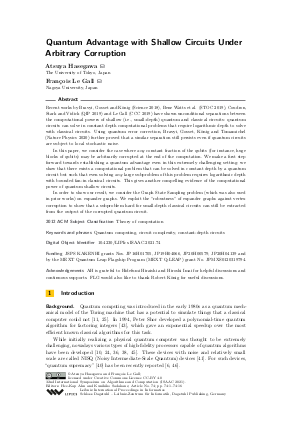@InProceedings{hasegawa_et_al:LIPIcs.ISAAC.2021.74,
author = {Hasegawa, Atsuya and Le Gall, Fran\c{c}ois},
title = {{Quantum Advantage with Shallow Circuits Under Arbitrary Corruption}},
booktitle = {32nd International Symposium on Algorithms and Computation (ISAAC 2021)},
pages = {74:1--74:16},
series = {Leibniz International Proceedings in Informatics (LIPIcs)},
ISBN = {978-3-95977-214-3},
ISSN = {1868-8969},
year = {2021},
volume = {212},
editor = {Ahn, Hee-Kap and Sadakane, Kunihiko},
publisher = {Schloss Dagstuhl -- Leibniz-Zentrum f{\"u}r Informatik},
address = {Dagstuhl, Germany},
URL = {https://drops.dagstuhl.de/entities/document/10.4230/LIPIcs.ISAAC.2021.74},
URN = {urn:nbn:de:0030-drops-155076},
doi = {10.4230/LIPIcs.ISAAC.2021.74},
annote = {Keywords: Quantum computing, circuit complexity, constant-depth circuits}
}

 Creative Commons Attribution 4.0 International license
Creative Commons Attribution 4.0 International license












































